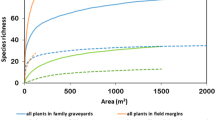Abstract
The objectives of this study were to analyze the biodiversity of the Traditional Gudeuljang Irrigated Rice Terraces in Cheongsando, South Korea’s representative GIAHS (Globally Important Agricultural Heritage System) site, with reference to position and land-use features, and to develop a plan to promote agricultural biodiversity in the region. We confirmed approximately 54,000 m2 of Gudeuljang paddy fields by an on-site survey. Of the Traditional Gudeuljang Irrigated Rice Terraces confirmed by onsite inspection, our survey showed that approximately 24,000 m2 are currently being used as paddy fields, approximately 15,000 m2 are being used as dry fields, and approximately 14,000 m2 are fallow. In terms of other non-agricultural land use, there was grassland, including graveyards; artificial arboreal land, such as orchards, rivers and wetlands, and man-made facilities, such as roads and residences. We also confirmed that the Traditional Gudeuljang Irrigated Rice Terraces had higher plant species diversity than conventional terraced rice paddies, and there was a difference in life form characteristics between the two types. Although the superficial topsoil structure is the same for the Traditional Gudeuljang Irrigated Rice Terraces (TGIRTs) and conventional terraced rice paddies, it is thought that the differences in the subsurface structure of the TGIRTs contribute greatly to species and habitat diversity. However, the TGIRTs in Cheongsando are facing degeneration, due to damage and reduction in agricultural activity. The main cause is the reduction in the number of farming households due to an aging population in Cheongsando. In order to address this problem, we proposed a management plan, related to fallow paddy fields in South Korea, to initiate voluntary activities in the TGIRTs.
Similar content being viewed by others
References
FAO (1999) Sustaining agricultural biodiversity and agroecosystem functions: opportunities, incentives and approaches for the conservation and sustainable use of agricultural biodiversity in agro-ecosystems and production systems. International Technical Workshop organized jointly by the Food and Agriculture Organization of the United Nations and the Secretariat of the Convention on Biological Diversity, with the support of the Government of the Netherlands FAO, 2-4 December 1998, FAO Headquarters, Rome, Italy, pp 59. (In English). Available on https://www.cbd.int/doc/case-studies/agr/cs-agr-1998-12-rpt.pdf. (Accessed on 2015-07-21)
CBD (Convention on Biological Diversity) (2000) Programme of work on agricultural biodiversity: review of phase I of the programme of work and adoption of a multi-year work programme. Decision V/5 of the conference of the parties to the convention on biological diversity, May 2000, Convention on Biological Diversity, Nairobi. (In English). Available on https://www.cbd.int/decision/cop/?id=7147. (Accessed on 2015-07-21)
Cho YJ, You HY, Yoon WK, et al. (2012) Geographical distribution and physical structure of gudlejang paddy-field in Cheongsando. Seoul, South Korea. Journal of Korean Society of Rural Planning 18(3): 103–110. (In Korean with English abstract). DOI: 10.7851/ksrp.2012.18.3.103
Cromwell E, Cooper D, Mulvany P (2001) Agricultural biodiversity and livelihoods: Issues and entry points for development agencies. In: Koziell I, Saunders J (eds.), Living off biodiversity: exploring livelihoods and biodiversity issues in natural resources management. International Institute for Environment and Development, London. pp 75–112. (In English). Available on http://www.eldis.org/vfile/upload/1/document/0708/DOC7300.pdf. (Accessed on 2015-07-21).
Hong SC, Byen SH, Kim SS (1987) Colored illustrations of trees and shrubs in Korea. Gyemyengsa, Seoul, South Korea. p310. (In Korean)
Jarvis DI, Padoch C, Cooper HD (2010) Managing biodiversity in agricultural ecosystems (Edited translation by National Academy of Agricultural Science). Rural Development Administration Republic of Korea, Biodiversity international, Columbia University Press, New York. p512.
Korea National Arboretum (2009) Korean Plant Name Index(used Microsoft Office Exel file). Korea National Arboretum. Pocheon, Gyunggi, South Korea. (In Korean). Available on http://www.nature.go.kr/newkfsweb/kfs/idx /SubIndex.do?orgId=kpni&mn=KFS_29#excelDown. (Accessed on 2015-07-21)
Lee WT (1996). Lineamenta florae Koreae. Academy press, Seoul, South Korea. p 624. (In Korean)
Lee CB (2003) Colored flora of Korea. Vol. I, II. Hyangmunsa, Seoul, South Korea,I: pp914; II: pp910. (In Korean)
Lee YM, Park SH, Jung SY, et al. (2011) Study on the current status of naturalized plants in South Korea. Seoul, South Korea. Korean Journal of Plant Taxonomy 41: 87–101. (In Korean with English abstract)
Melchior H (1964) A Engler's syllabus der pflanzenfamilien band II. Gebruder Bornteaeger, Berlin, Germany. p 666. (In German)
Millenium Ecosystem Assessment (2005) Ecosystems and human wellbeing. Vol 1: Status and Trends. Island Press, Washington DC, US. pp47. (In English)
Numata M (1970) Illustrated plant ecology Ashakura Book Co. Tokyo, Japan. pp 33–43. (In Japanese)
Numata M (1975) Naturalized plants. Dainippon-tosho, Tokyo, Japan. p 160. (In Japanese)
Park JJ, Kim SB, Lee EC (2013) Adoption and future tasks of nationally important agricultural heritage system for agricultural and rural resources conservation. Seoul, South Korea. Journal of Korean Society of Rural Planning 19(4): 161–175. (In Korean with English abstract). DOI: 10.7851/ksrp.2013.19.4.161
Raunkiaer C (1934). Life forms of plants and statistical plant geography. Charendon Press, Oxford, UK. p 682.
Wood D, Lenne JM (1999) Why agrobiodiversity? In: Wood D, Lenne JM (eds.), Agrobiodiversity: Characterization, utilization and management. CAB International, Wallingford, UK. pp 1–14.
Wondo County (2013) Traditional Gudeuljang Irrigated rice terraces in Cheongsando. Wando County, Jeollanam-do Provincial Government Republic of Korea. p 119.
Yoon WK, Choi SI (2012) Establishment of the agriculture and fisheries heritage system in Korea. Seoul, South Korea. Korean Society of Agricultural Extension 19: 465–495. (In Korean with English abstract). DOI: 10.12653/jecd.2012.19. 2.465
Acknowledgments
This work was supported by the research program of Dongguk University.
Author information
Authors and Affiliations
Corresponding author
Additional information
http://orcid.org/0000-0002-1685-9464
http://orcid.org/0000-0002-8512-9641
Rights and permissions
About this article
Cite this article
Park, H.C., Oh, C.H. Flora, life form characteristics, and plan for the promotion of biodiversity in South Korea’s Globally Important Agricultural Heritage System, the traditional Gudeuljang irrigated rice terraces in Cheongsando. J. Mt. Sci. 14, 1212–1228 (2017). https://doi.org/10.1007/s11629-015-3644-1
Received:
Revised:
Accepted:
Published:
Issue Date:
DOI: https://doi.org/10.1007/s11629-015-3644-1




